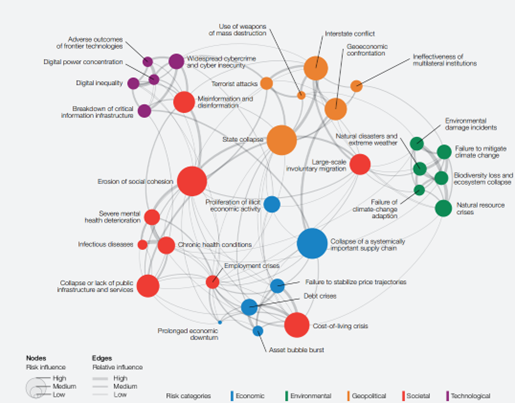The World Economic Forum recently released its Global Risks Report for 2023. My social networks were abuzz with summaries of the top risks – or perhaps commentary on selected risks that resonated with the person sharing it. But how useful are Top X Risks Lists?
In this blog we will cover:
- The Global Risks Report
- The illusion of ‘Top X Risks’ Lists
- How to make them relevant to you
Summarizing the Global Risks Report
Firstly, this blog isn’t a criticism of the WEF’s Global Risks Report. It includes some excellent information across broad global risk themes. The map of interconnections (pictured below) provides a good summary of systemic interaction, and there is great supporting information and reference material for some specific risks.

Source: WEF Global Risks Report
For this report, a global risk is defined as “the possibility of the occurrence of an event or condition, which, if it occurs, would negatively impact a significant proportion of global GPD, population or natural resources.”
It looks at risks across three time horizons: currently manifesting risks; the next two years; and 10 years. Survey respondents were asked to score 32 pre-defined risks, with the average used to rank the risks.
The illusion of the Top X Risks List
As humans, there is something about a ‘Top X List’ that attracts us. It’s a tried-and-true format. The numbers promise distinct pieces of information that are easy to digest. It suggests structure and consistency. Some are presented in a preferred order or ranking, giving us the promise of prioritized content that we can use or compare against our own understanding.
The issue with ‘Top X risks lists’ in particular is that risk is in the eye of beholder. The commonly used definition for risk from ISO 31000 is “the effect of uncertainty on objectives”. Every organization has different objectives.
This brings us back to the definition of global risks in the Global Risks Report, which relate to negative impact to GDP, population or natural resources. It’s probably reasonable to expect that many of the risks listed in the report will impact organizations to at least some degree; but for some they will be major, and for others they will be immaterial, depending on their objectives. For some organizations, the manifestation of one or more of these global risks may even represent opportunity.
It's also noteworthy that the ranking for the Global Risk Report is based on averages. It isn’t based on consensus (which is a topic for another day!) or agreement on how they should be ranked. For any individual risk, it will be made up of some people rating it highly, and others who see it as not important. The variation in opinion (missing from the report) can also be telling.
Can they be useful?
Top 10 risk lists or reports can still provide value. The first question to ask is ‘risk to what?’. This can then help you more effectively evaluate how those risks might translate to your objectives (if at all). It may help identify risks your organization hasn’t prepared for, or learn new information or nuance about existing risks.
Here are some tips or questions to consider when looking at these types of lists:
- What are the potential second- and third-order effects of some of these risks? Could they influence or undermine resources or capabilities we need to deliver our strategy?
- For macro risks like the Global Risks Report, could they change demand over time for the products or services we provide?
- Could these risks influence legislative or regulatory change?
- For risks that might be more directly relevant to your organization or otherwise pique your interest, review the cited sources for more relevant information (99.98% of US residents could be re-identified after data was anonymized? Added to my reading list!)
- For lists based on survey averages (such as the Global Risks Report), you might also consider looking at the outliers if that information is available. Is there something about those outliers (their perspective, sector, organization and other relevant context) that might make them more resonant for you and your objectives than the average?
- In the case of the Global Risks Report, pay more attention to the Appendices that include individual country rankings for the regions that you operate in (while keeping caveats about prioritization below into account)
- Take prioritization or rank ordering of risks with a grain of salt. That ranking might be appropriate for the context in which it was prepared, but always adapt to the objectives that matter to you or your organization.
Take-outs and next steps
In short, ‘Top Risks’ lists can be useful, just make sure to use them wisely. Sometimes they aren’t even risks – just trends. Look beyond the headline and identify what matters to you.
To find out more about how effective frameworks in which to identify, consider and manage risks, download our free Enterprise Risk Management – How to manage risk effectively across the enterprise eBook. This will provide you with a comprehensive view of what true Enterprise Risk Management is and to learn how it addresses the inherent problems in the traditional, siloed non-enterprise approach.
